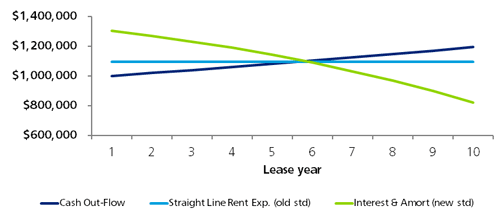Local tax counsel, Lou Weller of Deloitte, directed us to this insightful article about new accounting rules for office leases. Take it with a cup of coffee. If you find yourself sleepless, please feel free to call Deloitte or your favorite accountant with questions.
Market Insight: Guest Articles
New Lease Accounting Standard for Lessees
Is your organization prepared to cope with these new standards?
by Josh Leonard
Partner, Deloitte Financial Advisory Services LLP
April 2011
Key issues:
New lease accounting standards are currently being developed in a joint project between the IASB and FASB that could result in a complete overhaul of the way in which leases are reported in financial statements.
The new standard would effectively eliminate all “operating leases” and require them to be capitalized on the company’s balance sheet. It would also replace rent payment expense reporting with interest and depreciation expense reporting.
Some industry projections estimate over $1.3 trillion would be transferred to U.S. corporate balance sheets, with roughly 70 percent being real estate leases.
Below are the significant changes that are anticipated in the new FASB Exposure draft, some issues and impacts they create, and some of the ways Deloitte can assist your company in coping with these changes.
- Significant lessee accounting changes
- Lessee recognizes “right-of-use” as an asset and the “obligation to pay rentals” as a liability
- Right-of-use asset is initially recorded based on the present value of lease payments plus initial direct transaction costs, but less distinct operating expenses and property taxes
- The accounting lease term will be the longest possible lease term that is more likely than not to occur
- Contingent rentals (e.g., retail percentage rents) are required to be estimated and included in the initial measurement of the “right-of-use” asset and the “obligation to pay rentals”
- Lease term and payments are reassessed each reporting period to include changes in projected renewals and contingency rents
- Present value interest rate generally utilizes the lessee’s “incremental borrowing rate”
- Contingent rents that are based on an index (e.g., CPI) or rate would be determined using readily available forward rates. If forward rates are not readily available, the contingent rents would be estimated based on the current rate
- Right-to-use asset is amortized straight-line over the lease term along with declining interest expense based on the obligation to pay rentals liability
- Right-of-use asset is evaluated for impairment under existing standards for intangible assets
- No grandfathering of existing leases i.e., all leases would need to be reflected on the balance sheet upon adoption

- Graphic example of new lease income statement accounting compared to existing FASB 13 straight line rent
- Net base rent — $1,000,000 per year
- Rent escalates — 2 percent per year
- Lessee’s incremental borrowing rate — 7 percent
- Lease term 5 years with 1–5 year renewal likely — 10 years
- Significant lessee financial and operational impact
- “Rent” would disappear from the income statement
- Net Operating Income (NOI) would decrease in early years after effective lease date
- EBITDA would increase as rent is replaced by interest and amortization
- Financial ratios are affected due to newly inflated balance sheet with potential changes to debt/equity ratios, interest coverage ratios and loan covenants
- May lead to potential renegotiation of existing loan agreements especially for firms with capital adequacy concerns
- Business unit charge backs for departmental space usage expense would be greater in the early part of the lease potentially impacting HR issues surrounding executive performance metrics
- Although lessees may consider shorter term leases in order to reduce the balance sheet effects, this consideration would need to be balanced against the following effects of a shorter lease term
- Increased rents due to market uncertainty and
- Reduced landlord concessions for tenant improvements due to shorter recovery periods
- Potential increased reconsideration of ”buy” versus “lease” decisions for real estate driven by desire for more tenant control of space when balance sheet impact is no longer a distinguishing factor
- Major impact on corporate business units
- Corporate Real Estate
- Lease Administration
- Finance/Accounting
- Tax
- Information/Technology
- Human Resources
- Key dates
- Final standards issued end of 2nd Quarter 2011 —(estimate)
- Effective Date — Not yet determined. —Unlikely to be earlier than 2013.
Corporate real estate
If adopted, the new accounting standards will shine a bright light on the corporate real estate function. How will the changes affect overall real estate strategies and decision making? Some potential changes include:
- Buy versus lease decisions
- Long versus short term lease decisions
- Impact of renewals and purchase options on lease obligations
- Full Service (“Gross”) versus “Net” leases for reporting
- Subleasing and assignment issues
- Quarterly reporting and changes to lease accounting from lease renewals and contingency rents (CPI and Percentage Rent escalation projections)
Contact:
Financial Advisory Services
Josh Leonard
Partner
Deloitte Financial Advisory Services LLP
+1 213 553 1717
josleonard@deloitte.com
www.deloitte.com
Deloitte can assist your operations with:
- Finance, accounting and reporting
- Information technology and human resources
- Tax
These are just some of the support services Deloitte can provide to help your company through this significant accounting transition that will affect much of your enterprise. For more insight into how Deloitte can help you through this transition continue reading this article on their website.



